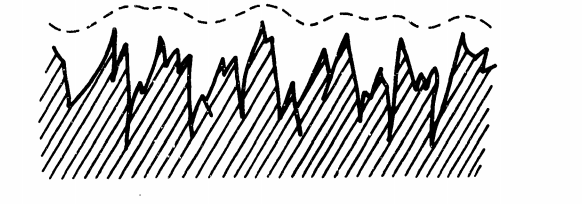INTRODUCTION
High precision and high `requency quartz resonators, particularly those for high shock applications, require quartz plates whose surfaces are free of imperfections, such as scratches and pits. The most common method of achieving such surfaces is mechanical polishing. The mechanical polishing processes are difficult to control (i.e., it is difficult to produce defect-free surfaces, at the correct frequency, with a high yield). Moreover, as has been' known since the last century, even when the polished surfaces appear to be free of defects when examined at high magnification, the surfaces contain hidden defIcts. 1 I 2 These defects can be revealed by X-ray diffraction topography and by etching subsequent to polishing.
Figure 1 is an SEM micrograph which shows the two most co.,only observed defects revealed by etching polished quartz blanks: scratch marks and pits. As we shall discuss later, the pits often extend deep into the blanks.
The objective of the study to be described in this report was to overcome the difficulties associated with mechanical polishing by finding an etching procedure capable of producing chemically polished quartz crystal surfaces.

Fig2
CHEMICAL POLISHING
At the beginning of this study, a literature search was conducted to determine what previous studies, if any, have been reported on the subject of polishing quartz chemically. No such reports were found. Perhaps, this is due to the fact that it has been widely known that the etch rates of quartz vary greatly with crystallographic direction. 4 ' 5 The rate along the fastest etch direction, the Z direction, is over one hundred times the rate along the slowest etch direction, which is the -X direction for right-handed quartz. At first glance, therefore, achieving a chemically polished quartz surface may seem like a hopeless task.
Under such conditions, the etching is principally determined not by the properties of the surface being etched, but by the diffusion. It is clear that if a surface initially consists of hills and valleys, as shown in Figure 2, the probability of an etchant molecule diffusing to the top of a hill will be much greater than the probability of its diffusing to the bottom of a valley. The hills will therefore be etched faster than the valleys, and the 3urface will become increasingly smooth as the etching progresses.
ETCHING EXPERIMENTS
Not cnough information exists at the present time for one to be able to predict the conditions under which a given etchant can chemically polish quartz. At the beginning of this study, an empirical evaluation of a number of the known etchants for quartz was planned. The evaluation began with ammonium bifluoride (VTH4 F*HF), simply because that had been the etchant used in our fabrication process and was therefore the most readily available. As it turned out, we need not have looked any further.
Most of the experiments were performed on AT-cut plano-plano natural quartz blanks which had been final lapped with 3 pm MICROGRIT aluminum oxide abrasive 7 and then etched under various conditions in increments up to Af - 160 foff, where Af is the change in frequency in kHz, and fo and ff are the initial and final frequencies, respectively, in MHz. In the past, the depth of etch has usually been expressed in units of f 2 because the depths of etch normally used in crystal fabrication have been small enough so that it did not matter if f meant fo or ff. For the deep etches evaluated in th e experiments, the proper unit is foff. (Since to and tf f I At h .) To ff -of For AT-cut quartz, lfoff = 1.66 Um removed from the thickness.
SURFACE EVALUATION
The etched blanks were first inspected with a light microscope to assure that no gross defects were present. The blanks were then examined with a scanning electron microscope (SEM) and with a Talysurf profile meter. 8
Inspection Procedure
The inspection of etched blanks is performed under a microscope at about 40 X magnification using a black background with the light incidence perpendicular to the axis of the microscope. First, the crystal is inspected for surface irregularities such as scratch marks, pits, and twinned areas by tilting the crystal so as to reflect light into the microscope. The crystal is then inspected for etch channels by holding it so that the light incidence is in the plane of the crystal (i.e., edge illumination). The etch channels are most visible when the edge illumination is incident along a direction perpendicular to the direction of the channels. For example, in most cultured quartz, the etch channels tend to be along directions near the Z direction. These channels are most easily visible, therefore, with a light incident from the X direction. To help make the etch channels more visible without rotating the crystals, it is helpful to use for the edge illumination two lights incident at a right angle to each other, or a ring light. The etch channels appear as small, bright streaks which extend through the blank from one side to the other. The thicker the blank, the longer the streaks; and the deeper the blank has been ecched, the brighter the streaks
上一篇: InGaAs薄膜波导
下一篇: 基于InGaAs异质结构的红外传感器